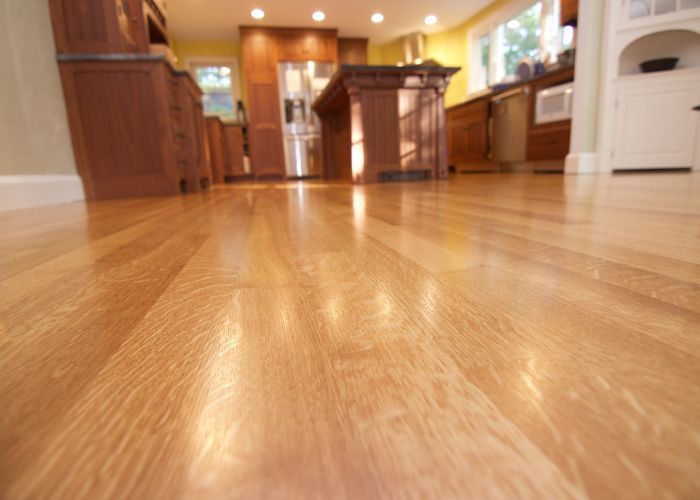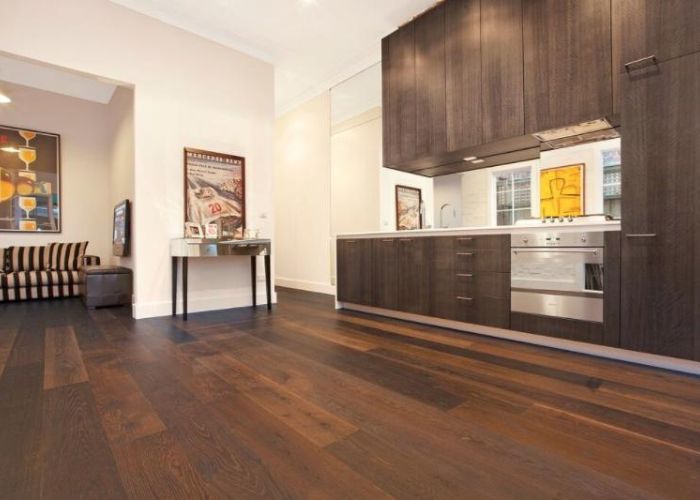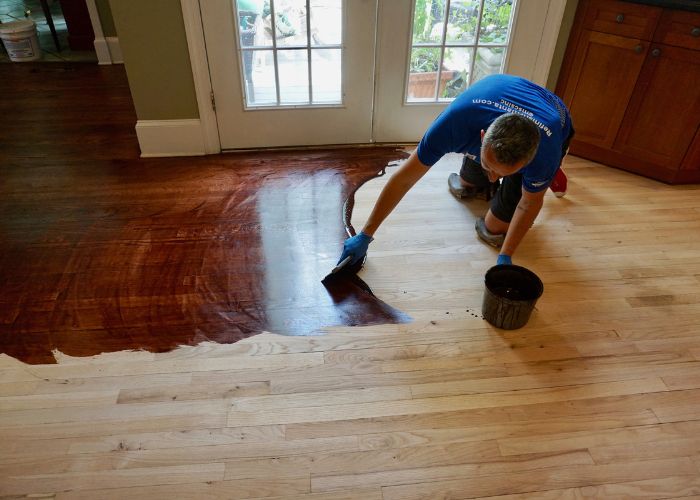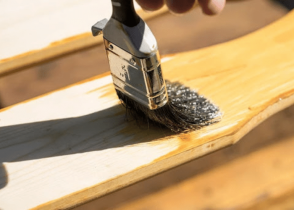Polyurethane and hardwood floors are a match made in woodworking heaven. Hardwood floors are timeless, fit in almost any design, and are reliable.
However, they are not indestructible, so it is important to know how to choose a polyurethane finish for hardwood floors.
The right polyurethane will provide protection for years from water, dents, scratches, and weird stuff that come out of pets… and babies (I’m just being honest).
The good thing about polyurethane is that you can’t really make a wrong choice, as it can easily be refinished, but let’s see if we can help you get it right the first time.
How to Choose a Polyurethane Finish for Hardwood Floors
A water-based polyurethane finish is widely considered the ideal option for hardwood floors and may be seen as a harbinger of what’s to come in polyurethanes. Comparable to oil-based finishes, high-level water-based polyurethane is simple to apply and better for your health and the safety of those around you and our planet.
Type of Polyurethane Finishes for Hardwood Floors

There are two major types of polyurethane finishes:
- Water-based polyurethane
- Oil-based polyurethane
There are a few other hybrid options, such as oil-modified water-based polyurethane. But it’s still just a water-based poly.
Both types of polyurethane do precisely the same thing and provide the same level of protection. Yes, back then, water-based polyurethane wasn’t as durable, but that has changed.
While oil-based and water-based are often interchangeable, there are some important differences that will influence your choice of floor finish. Here’s our comprehensive article on the difference between oil and water-based polyurethane.
Types of Polyurethane Finish
The options for polyurethane finishes include:
- Matte
- Satin
- Semi-gloss
- High gloss.
So let’s discuss each one in detail;
High gloss
High gloss is the most common polyurethane finish. A high-gloss finish will have a shiny, wet look to it when applied with polyurethane. It has the highest gloss rating of all.
Not often used on hardwood floor because it is very slippery. You are more like to see it on specialty wood species such as exotic hardwood floors or accent borders.
It is notorious for showing every imperfection and is therefore not suitable for high-traffic areas or families with children and pets.
If you need non slip polyurethane for wood stairs, here are the top-rated polyurethane for stair treads and floors that you should use. Read our guide for more information on how to make wood stairs less slippery.
Interested in making your wood floors less slippery? Discover effective techniques in our guide on how to make wood floors less slippery, ensuring both safety and style.
Matte:

A matte finish is not shiny at all. It provides a subtle but noticeable difference in appearance from flat paint. Matte polyurethane can be used on most hardwood flooring types like tiles, wood, laminate etc. This is usually an “in-between” floor finish that is not used often.
Matte finish hardwood floors have become increasingly popular in recent years for their aesthetic appeal and low maintenance needs. Many homeowners are drawn to the natural look of matte wood floors and the fact that they do not require the same intensive cleaning and care that high-gloss floors do.
When it comes to choosing the best wood flooring for your home, there are a few things to keep in mind. First, you’ll want to consider what type of wood you want. There are a variety of different woods available on the market, each with its own unique grain pattern and color.
Satin
A satin finish provides a subtle sheen with less glare than high gloss finishes. It is the best choice for hardwood floor and won’t show imperfections as much as high-gloss polyurethane will. A drawback to it, though, is if you have pets or small children, this floor finish could show scratches while matte polyurethane would not.
Semi-gloss
A semi-gloss provides the most durable protection for wood floors with moderate shine. It is a nice middle ground between high gloss and satin finishes in that it will protect your hardwood floor but also provide you with moderate shine.
Read more here to know the difference between satin and semi-gloss polyurethane.
How to Choose a Polyurethane Finish for Your Hardwood Floors
I hope you know how to put polyurethane on wood floors. Now let’s jump into what to consider before getting a suitable finish.
1. Color of the Polyurethane
The main difference between these two types is:
- Oil-based polyurethane has a yellowish or amber tint, and it becomes more yellow over time.
- Water-based polyurethane dries and remains clear.
When choosing a polyurethane finish, you need to think about how the color will affect your hardwood. You should ideally choose oil-based polyurethane for darker woods.
If you have white paint on the floors, a non-yellowing polyurethane for floors will help to maintain that color. However, there are not hard and fast rules because you might want that variety.
For example, even though maple is a light-colored wood, it still looks great covered in oil-based polyurethane.
It really does depend on your design scheme at the end of the day. But if you don’t want to see any changes over time, stick with water-based polyurethane.
2. Cost
I intentionally put this second because many people want to prioritize projects based on costs, but that is a mistake. You need to decide on how you want your floors to look over time before looking at prices.
The reason is that oil-based polyurethanes are cheaper than water-based polyurethane. Choosing the cheaper option won’t be helpful if you don’t want a yellow tint on your hardwood floor.
However, if you don’t mind or are using dark wood, then it’s fair game, especially when working on a large project.
If you need to coat the floors all over your house, in a gymnasium, or some other large area, the best polyurethane for floors will do the job.
3. Drying Time
Another important factor to consider is the time constraint of the project. If you need a quick turnaround, then you should go with a product with a quick dry time.
The winner in this category is water-based polyurethane. Water-based polyurethane can be ready for a second coat in as little as two hours, unlike oil-based polyurethane that needs 24 hours.
Even fast-drying oil-based polyurethane needs at least 4 hours, but these are slightly more expensive than the regular stuff. (Find out what to do when poly doesn’t dry in our comprehensive article.)
After you have applied the final coat, water-based polyurethane will cure in 1 to 3 days. On the other hand, oil-based polyurethane needs about two weeks to cure properly.
Interesting Post: How to Remove Dark Urine Stains From Hardwood Floors
4. Ease of Application

This is kind of a tricky one to gauge. Technically speaking, and I’ll explain what I mean, water-based polyurethanes are easier to apply in a minute.
Both types of polyurethane are applied the same way, with just some minor differences. For example, you need a different type of brush or steel wool, the thinning agents are different, and the wait times are also distinct.
What makes water-based polyurethane easier to apply is that you don’t always need to sand between coats. Let me rephrase that: most manufacturers say you don’t need to sand between coats.
As long as the hardwood floor don’t have any dust, you can apply another coat of water-based polyurethane without sanding.
That is a huge time-saver and cost-cutter if you know how much time to wait between coats of polyurethane on wood floor.
However, water-based polyurethane tends to raise the grain of the wood, so you need to apply more coats than oil-based poly to get a smooth finish.
Three coats of oil-based polyurethane are all you need, whereas you can apply as many as seven coats of water-based polyurethane.
If there are bubbles, dust nibs, or flint in the water-based polyurethane, you will need to sand as standard, which then makes it a more difficult finish to apply.
Also, find out how to use wipe-on poly to achieve a smooth finish on your woodworking projects.
5. Odor
As random as this might seem, you will be spending hours or even days applying this floor finish, so it is important to pay attention to this.
Water-based polyurethane doesn’t have much of an odor and emits considerably less volatile organic compounds (VOCs), making it better for your health and the environment.
Oil-based polyurethane, on the other hand, is a very stinky product! You need to wear a respirator when applying this. And yes, it releases higher VOCs, making it more harmful to the environment.
Read: How to clean brush after polyurethane
6. Luster or Type of Finish
Another thing that may affect your decision is the level of gloss or luster you want. Both water-based and oil-based polyurethane come in matte, satin, semi-gloss, and high-gloss.
As you would imagine, these different grades pop more with oil-based polyurethane. While you can use any of these, matte and high-gloss are not common options for hardwood floors that see a lot of traffic.
A high-gloss water-based finish will reveal scratches and scrapes easily. Oil-based polyurethane looks excellent in satin, semi-gloss, and high-gloss, thus giving it a slight advantage.
Read also: What is the best polyurethane for wooden countertops?
What Kind of Polyurethane Should you Use on Hardwood Floors?
As you can see, knowing how to choose a polyurethane finish for hardwood floors is a straightforward process. (Also, read our guide on how to polyurethane a table)
You need to determine how you want your floors to look, your budget, the time frame you are working with, and your feelings about odors and the environment.
To help make your decision easier, we have written a roundup review of the best oil-based polyurethane finish for hardwood floors and the best water-based polyurethane for hardwood floors.


The best oil base polyurethane on the market is Dura seal hand’s down!! The best water base polyurethane is Bona Tech Traffic HD. No question. I have 30 plus years in the business. I would say though that Traffic hd. Is not recommended for amateur use. Nor would I recommend any catalized finish for the amateur!!
Your videos were extremely helpful…
I’m getting ready to tackle a project & need some advice…
I own a home that was built in the 50’s, and it has vintage parquet flooring…Each square appears to be red oak tongue & groove, is 9″ x 9″, composed of 4 fingers…approx 1.5″ x 9″ each.
The house was rented, and the previous tenant damaged a few areas of the floor, and I notice some termite damage on some of the flooring as well…So to keep cost down, I’ve decided to remove the damaged sections, and replacing them with lumber I purchased at a lumberyard…
(Red oak tongue & groove slats that are the same size as the original wood) and they’ve been cut to 9″ lengths…
The original flooring in the entire house is on a concrete slab, and we’ve removed & cleaned up, as best as we could, the God Aweful black sticky adhesive that was used back in the 50’s…
So now…this is where I need your advice…
If possible…I’d rather not re-do the entire floor…I’d like to just match up the stain & apply urethane to the new wood, and place them in the areas that were damaged.
I’m considering staining & adding the urethane to the pieces (fingers) in my garage, while following all the directions, and letting them dry completely, and then installing them with adhesive to the concrete slab in the areas that I removed where the wood was damaged.
Here are my questions…
1. I’m unsure which adhesive to use…What do you recommend?
2. Once I have all the wood squares/fingers in place, I’d like to use a filler that I can match up color wise, with the stain I select for the joints in between each square…What do you recommend for this?
3. And once the floor is all put back together, would I be able to then go over ALL of the flooring, (new pieces & the existing floor) to seal it with a coat of urethane?
The existing floor appears to have urethane on it already, from “many” yrs ago… 20 yrs or more…just dont know how many coats were applied back then, or if it was oil or water-based urethane…
Would I have to sand all of the floors, before applying a new coat of urethane, or can I simply place a coat or two over everything, without sanding it?
4. And last but not least…
What do you recommend I use to clean the existing parquet floor? It’s a bit dull…but not too bad, but, it does need cleaning…I just dont know what to use…What would work well, so I can spruce it up before topping it off with another coat or two of new urethane…
Sorry for the LENGTHY story, but I just wanted you to know exactly what I’m trying to do, so it will be done properly.
Just so you know…I intend on renting it out again, once the job is completed….And I need to know what cleaning instructions I can give to the new tenants to avoid any damage in the future…
Your assistance and recommendations on this project would be very much appreciated.
I’d like to get it done as soon as possible.
Thanking you in advance for your expert opinion.
Hi Pat,
I saw you don’t have an answer yet so here’s some professional help (I own https://cmchardwoodfloors.com in Los Angeles). One tip with getting a better match is to remove some of the parquet flooring from a closet or under an appliance, and use those original pieces for the repair in the more visible areas. Then use the new oak you purchased in those spots.
To answer your questions:
1. The best professional product is Wakol. A small tube of their MS 265 or 232 Parquet Adhesive should do the trick.
2. Either Glista Wood Flour Cement (which uses the dust from your floor for an exact match), Timbermate or Woodwise filler that matches your wood floor would work. Make sure you have red oak and not white oak or it ill look different… that’s why the first product is the best to use in these situations.
3. Yes. This will ensure you have an even sheen. Use a matte or satin sheen to mask imperfections better.
4. Best to deep clean it first with either Bona Deep Clean Solution, or Basic Coatings Squeaky and then Tycote, or Loba Remover then WS 2K Contact. Either system will work well, so depends on availability. The Tycote and WS 2K Contact products ensure good adhesion to the existing (cleaned) finish.
As for instructions for the new tenants, supply them with either the Bona Cleaner or Basic Coatings Squeaky cleaner and tell them to use nothing else. Here is a link to the Cleaning Guide we give our customers: https://cmchardwoodfloors.com/Cleaning_Guide.pdf
Hope that helps. Marcos.